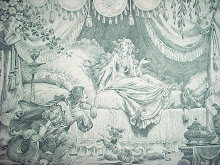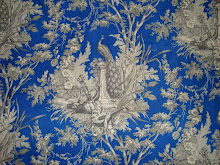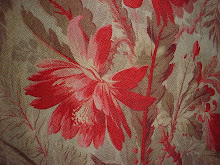









Here are a couple of pieces of 18th century Aubusson tapestry, hand woven from wool, dyed with natural dyes, the colours are so earthy and beautiful. One is an old chair seat cover, and dates to about 1770, the other looks like a fragment of a border from a large hanging, and dates to about 1750, maybe even earlier, but i am not too sure, as I am only just beginning to research this type of textile.
Tapestry is often used to describe needlework of various types, but these are not true tapestries, tapestry is created on a loom, working from a 'cartoon', or picture drawn to the exact size of the textile to be created. The colours are worked into the weft along with the background in order to create the patterns and pictures as a whole, rather than stitched into place as is the case with needlepoint. Tiny splits are left in the pattern during colour changes. Once the piece is finished, and removed from the loom, most of these gaps are carefully hand sewn together, these are known as 'sewings', and can be seen in some of the closeups here if you click on the photos to see the supersize pictures.
I love this type of textile, so old and beautiful, I am always thrilled when I come across a scrap, the detail is always wonderful, it evokes the period in a unique way. Tapestries were made for the rich, not just for decorative purposes, they were incredibly practical. The heavy weight of them kept out draughts, and kept in the heat, so beauty and practicality all in one wonderful item, as is so often the case with textiles!
Tapestry is often used to describe needlework of various types, but these are not true tapestries, tapestry is created on a loom, working from a 'cartoon', or picture drawn to the exact size of the textile to be created. The colours are worked into the weft along with the background in order to create the patterns and pictures as a whole, rather than stitched into place as is the case with needlepoint. Tiny splits are left in the pattern during colour changes. Once the piece is finished, and removed from the loom, most of these gaps are carefully hand sewn together, these are known as 'sewings', and can be seen in some of the closeups here if you click on the photos to see the supersize pictures.
I love this type of textile, so old and beautiful, I am always thrilled when I come across a scrap, the detail is always wonderful, it evokes the period in a unique way. Tapestries were made for the rich, not just for decorative purposes, they were incredibly practical. The heavy weight of them kept out draughts, and kept in the heat, so beauty and practicality all in one wonderful item, as is so often the case with textiles!



































































































Fabulous tapestry Lois. Thanks for the comment - and poor Pauley now has to cope with a day at the Home Spun Fair in Cornwall on Sunday. He's such a martyr!!!! However, he HAS decided that there's no need for him to accompany me next time I go to Ardingly!!!! Can't think why!
ReplyDeleteShall look forward to seeing you again in September maybe!
Sue x
This is knowledge that is new to me...how these pieces were created. Fascinating and you explained it all so well and clearly. So when you come across a small piece, how do you envision the use of such a beautiful thing? I only know about needlepoint pieces that are worn and have such lovely patina. These are so very special, aren't they? Thank you for the brief lesson. I think we could use some and save on our heating bills in winter. What an elegant way to sustain ourselves.
ReplyDeleteWhat a wonderful insight, we should perhaps think about using similar types of textiles as indoor insulating! I will be wracking my brains to think of how I can achieve a similar effect here before winter,a challenge indeed!
ReplyDeleteI have seen similar tapestry fragments wonderfully framed, especially if they have quite a bit of damage, as the framing and backing process can both support and disguise any holes etc. If the tapestry is strong enough, it makes a marvelous centrepiece on a cushion front, with complimentary fabric and trim. In the book Antique French Textiles for designers by June K Laval, she shows a photo of a couple of tiny scraps decorating a purse, or bag!I think I will do a post showing some of her cunning uses of antique scraps, both innovative and eco-chic! x
Just bought a scrap of Aubusson tapestry from you, went online to research it, and here you are!! Great to know more about you. I scrutinise fabrics with a magnifying glass. There's a time line story in each one: intriguing slip ups, mending, patching, all done because the fabric was so indispensable. I'm in heaven when I obtain a scrap!!
ReplyDelete